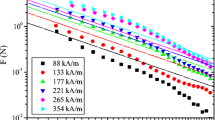Abstract
We develop a multiscale approach to describe the behavior of a suspension of solid magnetizable particles in a viscous non-conducting fluid in the presence of an externally applied magnetic field. By upscaling the quasistatic Maxwell equations coupled with the Stokes’ equations, we are able to capture the magnetorheological effect. The model we obtain generalizes the one introduced by Nueringer and Rosensweig (Phys Fluids 7:1927–1937, 1964) and Rosensweig (Ferrohydrodynamics, Dover Publications, Mineola, 2014) for quasistatic phenomena. We derive the macroscopic constitutive properties explicitly in terms of the solutions of local problems. The effective coefficients have a nonlinear dependence on the volume fraction when chain structures are present. The velocity profiles computed for some simple flows exhibit an apparent yield stress, and the flow profile resembles a Bingham fluid flow.







Similar content being viewed by others
References
Bossis, G., Lacis, S., Meunier, A., Volkova, O.: Magnetorheological fluids. J. Magn. Magn. Mater. 252, 224–228 (2002)
Condon, E.H., Odishaw, H.: Handbook of Physics. McGraw-Hill, New York (1958)
Goldasz, J., Sapinski, B.: Insight into Magnetorheological Shock Absorbers. Springer, Berlin (2015)
Halsey, T.C.: Electrorheological fluids. Science 258, 761–766 (1992)
Hecht, F.: New development in freefem++. J. Numer. Math. 20, 251–265 (2012)
Hoppe, R.W., Litvinov, W.G.: Modeling, simulation and optimization of electrorheological fluids. In: Glowinski, R., Xu, J. (eds.) Numerical Methods for Non-Newtonian Fluids, Handbook of Numerical Analysis, pp. 719–793. Elsevier, Amsterdam (2011)
Levy, T.: Suspension de particules solides soumises á des couples. J. Méch. Théor. Appli. Numéro Special, 53–71 (1985)
Levy, T., Hsieh, R.K.T.: Homogenization mechanics of a non-dilute suspension of magnetic particles. Int. J. Eng. Sci. 26, 1087–1097 (1988)
Levy, T., Sanchez-Palencia, E.: Einstein-like approximation for homogenization with small concentration. i. Elliptic problems. Nonlinear Anal. 9, 1243–1254 (1985)
Lipton, R., Vernescu, B.: Homogenization of two-phase emulsions. Proc. R. Soc. Edinb. 124A, 1119–1134 (1994)
Lopez-Lopez, M.T., Kuzhir, P., Lacis, S., Gonzalez-Caballero, F., Duran, J.D.G.: Magnetorheology for suspensions of solid particles dispersed in ferrofluids. J. Phys. Condens. Matter 18, 2803–2813 (2006)
Mei, C.C., Vernescu, B.: Homogenization methods for multiscale mechanics. World Scientific, Singapore (2010)
Milton, G.: The Theory of Composites. Cambridge Monographs on Applied and Computational Mathematics. Cambridge University Press, Cambridge (2002)
Nika, G., Vernescu, B.: Asymptotics for dilute emulsions with surface tension. J. Elliptic Parabol. Equ. 1, 215–230 (2015)
Nueringer, J.L., Rosensweig, R.E.: Ferrohydrodynamics. Phys. Fluids 7, 1927–1937 (1964)
Perlak, J., Vernescu, B.: Constitutive equations for electrorheological fluids. Rev. Roum. Math. 45, 287–297 (2000)
Rabinow, J.: The magnetic fluid clutch. AIEE Trans. 67(17—-18), 1308 (1948)
Rosensweig, R.E.: Ferrohydrodynamics. Dover Publications, Mineola (2014)
Ruzicka, M.: Electrorheological Fluids: Modeling and Mathematical Theory. Lecture Notes in Mathematics. Springer, Berlin (2000)
Sanchez-Palencia, E.: Non-homogeneous Media and Vibration Theory. Lecture Notes in Physics. Springer, Berlin (1980)
Shliomis, M.I.: Effective viscosity of magnetic suspensions. Sov. J. Exp. Theor. Phys. 34, 1291–1294 (1972)
Tao, R.: Super-strong magnetorheological fluids. J. Phys. Condens. Matter 13, 979–999 (2001)
Vernescu, B.: Multiscale analysis of electrorheological fluids. Int. J. Mod. Phys. B 16, 2643–2648 (2002)
Winslow, W.M.: Induced fibration of suspensions. J. Appl. Phys. 20, 1137–1140 (1949)
Chen, G., Yang, Y., Lin, L., Li, W.: Magnetorheological properties of aqueous ferrofluids. Soc. Rheol. Jpn. 34, 25–31 (2005)
Acknowledgements
G.N. was partially funded by the Deutsche Forschungsgemeinschaft (DFG, German Research Foundation) under Germany’s Excellence Strategy, The Berlin Mathematics Research Center MATH+ (EXC-2046/1, Project ID: 390685689) in project AA2-1, and would like to express his gratitude to Konstantinos Danas and Andrei Constantinescu for their fruitful discussions and suggestions.
Author information
Authors and Affiliations
Corresponding author
Additional information
Publisher's Note
Springer Nature remains neutral with regard to jurisdictional claims in published maps and institutional affiliations.
Rights and permissions
About this article
Cite this article
Nika, G., Vernescu, B. Multiscale modeling of magnetorheological suspensions. Z. Angew. Math. Phys. 71, 14 (2020). https://doi.org/10.1007/s00033-019-1238-4
Received:
Published:
DOI: https://doi.org/10.1007/s00033-019-1238-4




